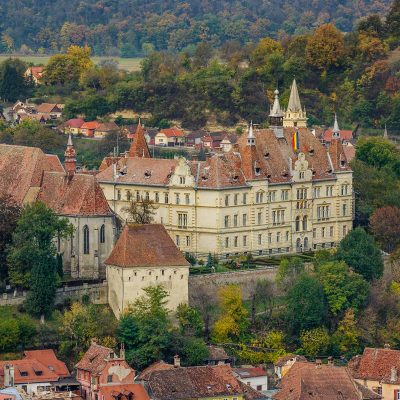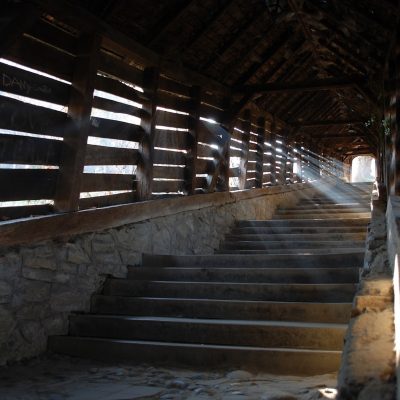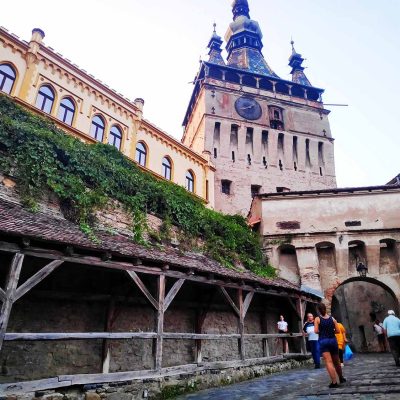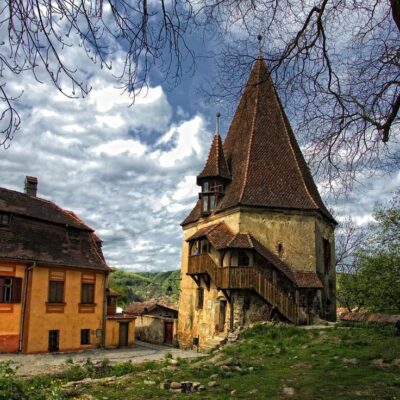Sighisoara, nicknamed “The Pearl of Transylvania”, is a medieval town that houses a fortress which seems to be straight out fairy tales. It is the ideal place for romantic walks on the cobbled and narrow streets, for forgetting about the stresses of the modern lifestyle and for rediscovering medieval life. Although time has left its mark on the city, the cultural and historical richness seems to be amplified by each tourist who is impressed by everything that Sighișoara has to offer.
The first documentary attestation of Sighișoara was made in 1280, under the name of “Castrum Sex“. In 1339 it became a county, and in 1367, a city. In the Middle Ages, the fortress was often subjected to Ottoman attacks. Despite the trials it went through during the 16th century, Sighișoara was a very important player on the Transylvanian political scene. Subsequently, the periods of Habsburg and Austro-Hungarian rule followed. In 1940 the Romanians became the majority population, and in 1968 Sighișoara became a municipality.
One thing worth mentioning in this regard is the fact that Vlad Țepeș was born in Sighișoara, a historical figure and, at the same time, the source of inspiration for Bram Stoker’s main character in his book, Dracula.
Sighișoara is located in the central part of the country, in the Hârtibaciu Plateau, part of the Târnavelor Plateau which, in turn, is an integral part of the Hilly Depression of Transylvania. Sighișoara is the second largest city in Mureș County.
The city is surrounded by tall hills, and the neighbouring counties are: to the north – Bistrița-Năsăud, to the east – Harghita, to the south – Sibiu and Brașov, to the west – Cluj and Alba.
The Sighișoara Fortress – was built in the 12th century by the Saxons and has heroically stood the test of time. Within the citadel lies the old town of Sighișoara, which was included in the UNESCO World Heritage Site in 1999.
The citadel is surrounded by a 930 m long wall, initially standing at approximately 4 m high. Later, the wall height was increased in some places to 14 m. The wall was constructed between the 14th and 17th centuries to protect the citadel against Turkish attacks. It had 14 towers, of which 9 have survived to this day. The towers served as headquarters for the guilds of craftsmen and artisans in the city.

The Covered Staircase – was designed to facilitate access for students to the school at the top of the hill. Presently, it retains 174 of the original 300 steps it had when first constructed in 1642.

The Clock Tower – like other constructions of that time in Romania, the Clock Tower is one of the symbols of the city. It was built in the 14th century for military purposes, primarily to protect the main gate of the citadel.
The tower stands at 64 meters tall and is visible from anywhere in Sighișoara. In the early 17th century, the building received a reconstructed clock installed by Johann Kirschel. The clock features lime wood statues, each 0.80 meters tall, representing pagan gods personifying the days of the week: Diana (Monday), Mars (Tuesday), Mercury (Wednesday), Jupiter (Thursday), Venus (Friday), Saturn (Saturday), and the Sun (Sunday).
The clock we see today is newer, specially manufactured and installed by the Swiss company Fuchs in 1906.

The Monastery Church – dating back to the 13th century, it is considered the most valuable architectural monument in the city. The most significant aspect is that it initially belonged to a Dominican church, whose existence came to an end.
The church was restored twice in the 20th century: initially in 1934 and then in 1992-2003. Today, it functions as a museum of Saxon art and a Romanian-Saxon cultural center.
It is also the church where George Rákóczi I was elected Prince of Transylvania and King of Hungary in 1631.

The Shoemaker’s Tower – it is one of the nine towers that served as defense points of the medieval fortress. Built in the 14th century, it “shelters” the second gateway into the citadel. The building is located in the north-western corner of the medieval precinct and served as a flanking tower to control the road linking the center to the eastern part of Transylvania, along the Târnava Mare river.
The structure, with Baroque architectural influences, is notable for its pentagonal plan, with an outer diameter of 10 meters and a roof that houses two small and elegant observation towers. The facade of the tower has changed over time, especially after its transformation into an archive depot after World War II. Currently, the tower houses the local radio station.

The nearest airport to Sighisoara is at Sibiu, 73 kilometres away.
Sighișoara can be reached by train – Bucharest – Brașov – Teiuș rail route, with derivations to Arad and Cluj-Napoca – Oradea.
If you prefer a faster option, you can choose to travel by bus/minibus. Here you will find all the necessary information for this: bus stations and stops, departure and arrival times, destinations.
You can reach Sighișoara by car on the following routes:
If you like music festivals, in Sighisoara you will find one to your taste, regardless of the style of music you prefer. Here you have a list with some of them:
What are you waiting for?
Come and have a good time, enjoy music, nice people and magical places.
